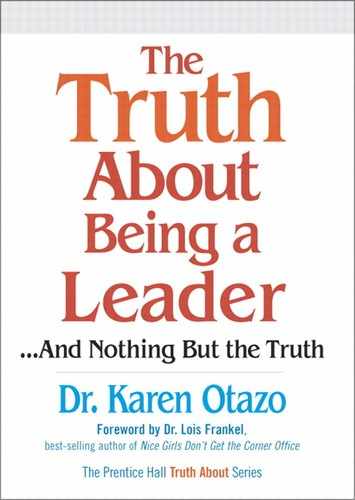Truth 43
Ideas Come Across Differently With Different Media
The classic image of the newshound stalking a scoop through the city streets is an anachronism. Today's reporters cruise the Internet for news via blogs and podcasts, keeping up with new communication technology. Take a page from their book.
Whatever your organization, communication media matter. They are the means through which messages about your organization, good and bad, are transmitted to the outside world. Even if you don't actively seek out media or press opportunities, they will find you.
Once your company has a profile in the outside world, others—including journalists—take an interest in what you're doing. That interest isn't just in the positive. The press, for example, doesn't just report what you want it to, but selects what it thinks will interest readers and viewers. It's your job to package and position your company information so that it's picked up when and how you want.
Dealing with media effectively requires a good understanding of the different forms and their practices. Each information delivery method requires a different approach to getting your message out. To use media effectively, keep the following points in mind.
Print Media
Newspapers and magazines carry general overviews of news in brief alongside in-depth features on particularly interesting areas. Find out which publications are most relevant to your organization by researching their readership and reading their editorials. Then capture their attention by thinking up angles to pique readers' interest, summing these up in a press release to be faxed or e-mailed to the publication. Don't just wait for big news items; keep the press informed of changes such as new staff appointments. This is a good source of publicity for your organization. In fact, giving media sources interesting tidbits from time to time creates a relationship with them for future connections.
Even if you don't
actively seek out
media or press
opportunities, they
will find you.
Visual Media
Visual images grab people's attention and linger in their memories. Studies have shown that people remember much more of what they see than what they hear. You should therefore carefully invest resources in generating the best possible images—still and moving—of you and your organization, ensuring that these are symbolic of what you want people to remember.
Moving images (video footage) are more prevalent, shown not only on television but via the Internet, and even downloaded to phones and iPods. It is therefore more important than ever to have professionally prepared, up-to-date video footage on hand. It's worth paying for some training so that you feel confident before the camera and can articulate your message clearly and concisely.
New Media
The Internet or World Wide Web has become one of the principal ways of sharing information, news, and opinions. The Web portal Google is used so often as a real-time, evolving encyclopedia that "to google" is now a verb. The first thing many people do when researching a company or individual is to type the name into an Internet search engine and see what comes up.
Having a well-designed and up-to-date Web site is essential for any contemporary organization. Many companies use their Web front page as their news page to convey events to others quickly and easily, without their having to trawl through the whole site. The trick is to keep each piece of news brief (people don't like to read long pieces of text on-screen) and to offer links to as many points of interest as possible. And keep your news up to date. There's nothing worse than old news hanging around when your organization has up-to-the-minute news that needs to be reported.
The other Internet feature to consider is the blog. Blogs, or Web logs, are online journals maintained on a dizzying range of topics by anyone who can master the basic technology. This means that you need to pay attention not only to what you place on the Internet, but also what others say about you. Blogs wield increasing influence with consumers; it takes only one popular blogger expressing an online grievance with your company to cause a whole host of public relations problems. Get your computer technician to set up a Really Simple Syndication (RSS) feed to allow you to keep track of what's new on the Web in your areas of interest, including your company. That way, you'll avoid nasty surprises.
Understanding the particular characteristics of each communication avenue helps you get your message across effectively. It pays to anticipate the needs of reporters and researchers and to package news in ways that make it easy to understand and communicate.
